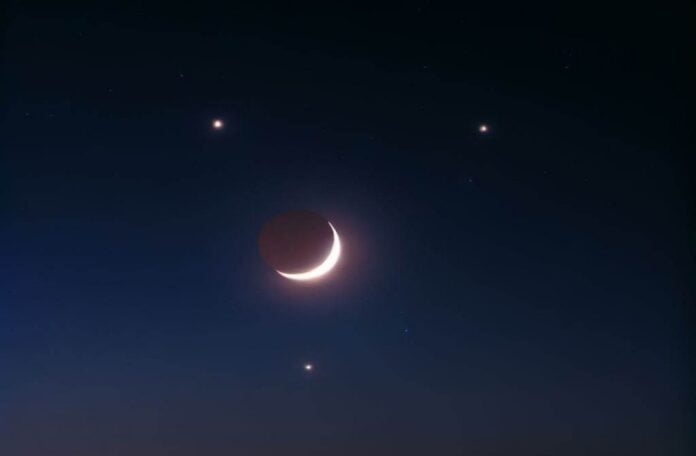In July, the moon will pass close to all five planets visible to the naked eye from Earth. This rare event will provide stargazers with a unique opportunity to see the planets in close proximity to each other.
The first conjunction will occur on July 7, when the moon will be visible just below Saturn. On July 11, the moon will be positioned slightly above Jupiter.
From July 19 to July 21, Mercury, Venus, and Mars will be closely grouped with a slender waxing gibbous crescent moon in the early-evening western night sky. On July 19, the crescent moon will be barely 5% lit, so this will be the hardest night to see it close to the rocky planets. However, bright Venus will be obvious alongside the crescent moon, while Mars will be easily seen above.
On July 20, the crescent moon will be much easier to see. It will be 10% lit and will shine alongside Mars, just above Venus. Mercury will remain low on the west-northwest horizon. While you’re gazing at the trio of planets, look for “Da Vinci glow” on the dark limb of the moon. Also called Earthshine, the phenomenon is caused by reflected sunlight from Earth’s oceans, clouds, and ice.
On July 21, a 16%-lit crescent moon will appear even higher above the western horizon, but it will be aligned with Mars and Venus. Mercury will be to the right of Venus.
On the following nights, the moon will depart the scene and climb higher into the post-sunset sky, with Venus sinking into the sun’s glare while Mercury continues to rise above it. On July 28, Mercury will shine within just a tenth of a degree of Regulus in twilight. It should be an excellent sight, even to the naked eye.
The Planets
The planets that will be visible in July are Saturn, Jupiter, Mercury, Venus, and Mars. Jupiter is the largest planet in the solar system, and it is easily visible to the naked eye. Saturn is the second largest planet, and it is also a bright object in the night sky. Mercury is the closest planet to the sun, and it is often difficult to see. Venus is the brightest planet in the sky, and it is often mistaken for a star. Mars is the fourth planet from the sun, and it is a reddish-orange color.
How to See the Planets
The best time to see the planets in July is in the early evening, after sunset. You will need to find a clear view of the western horizon. If you have binoculars or a telescope, you will be able to get a closer look at the planets.
Conclusion
The conjunction of planets in July is a rare event that is not to be missed. If you have the opportunity to see the planets, be sure to take it. It is a truly magical sight.
I hope you enjoy observing the planets in July!

You need to switch Jupter and Saturn where you say “Saturn is the largest planet..”